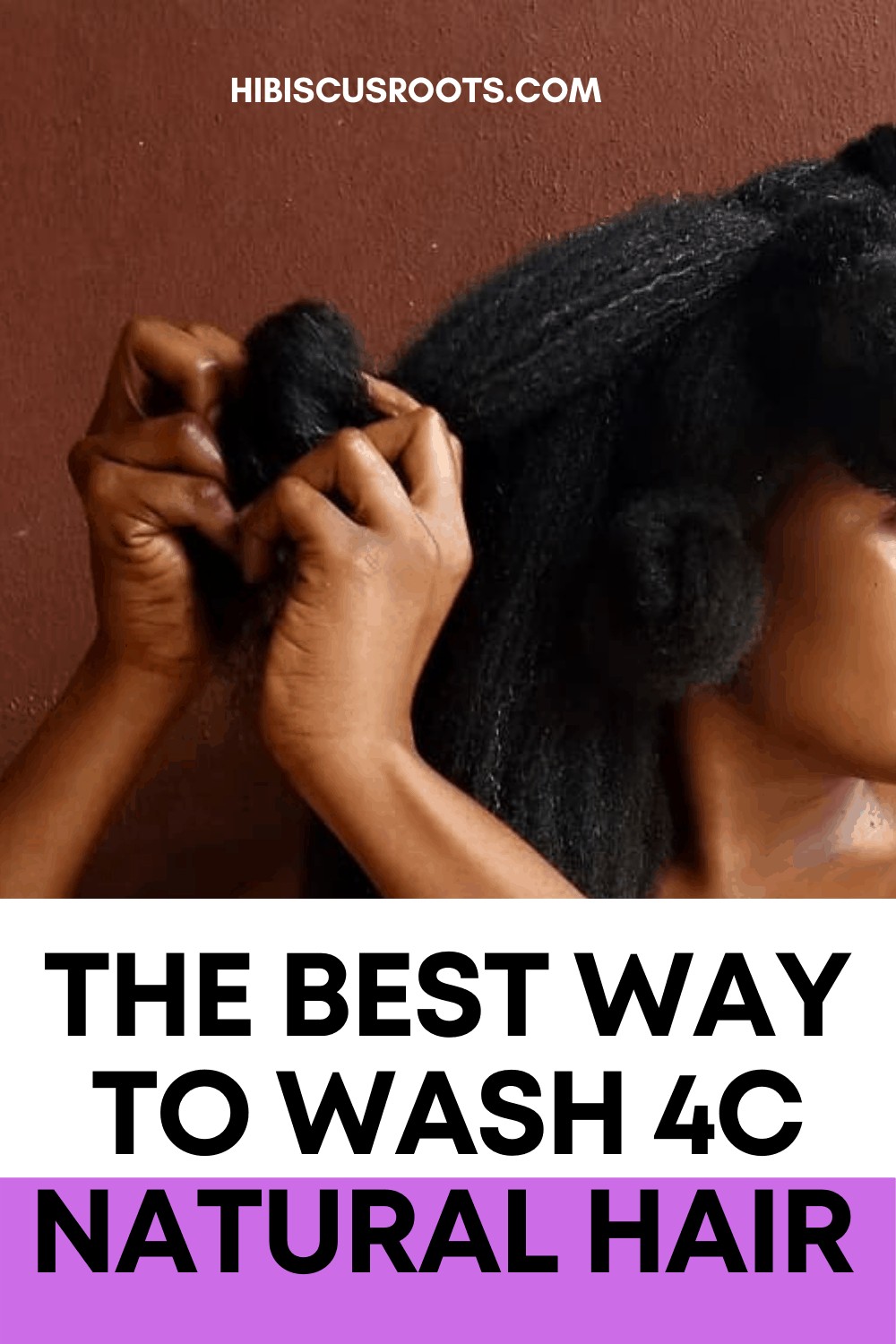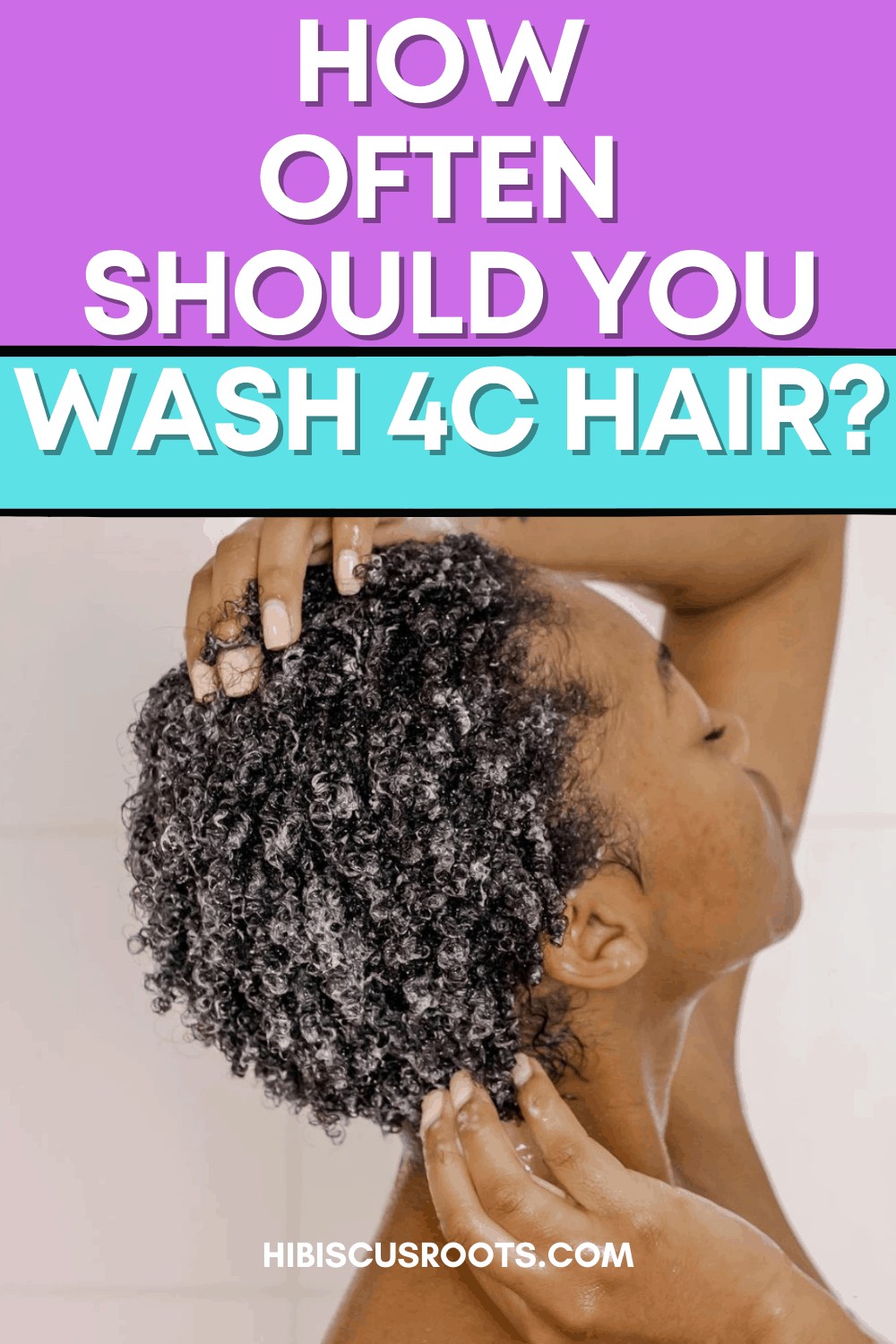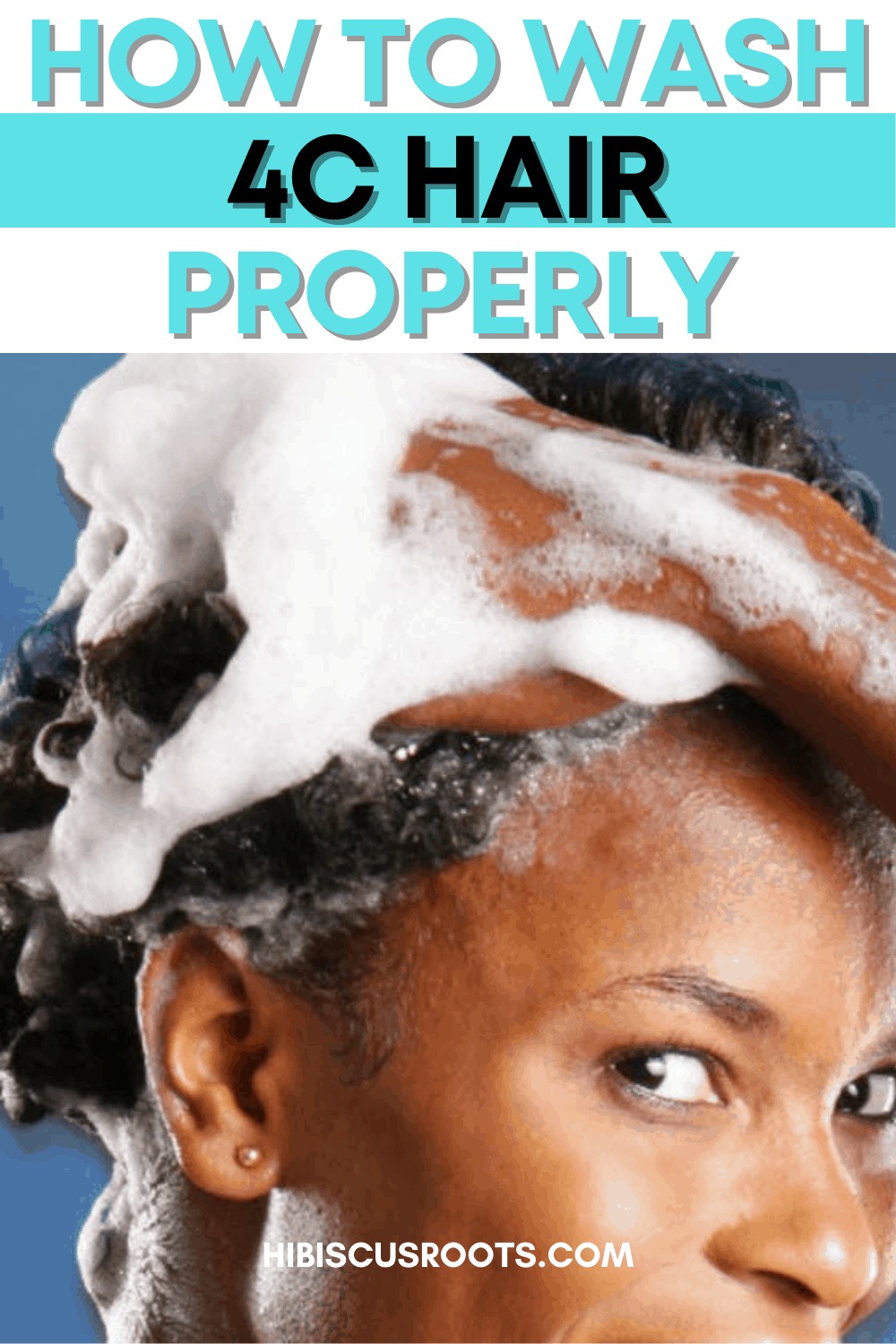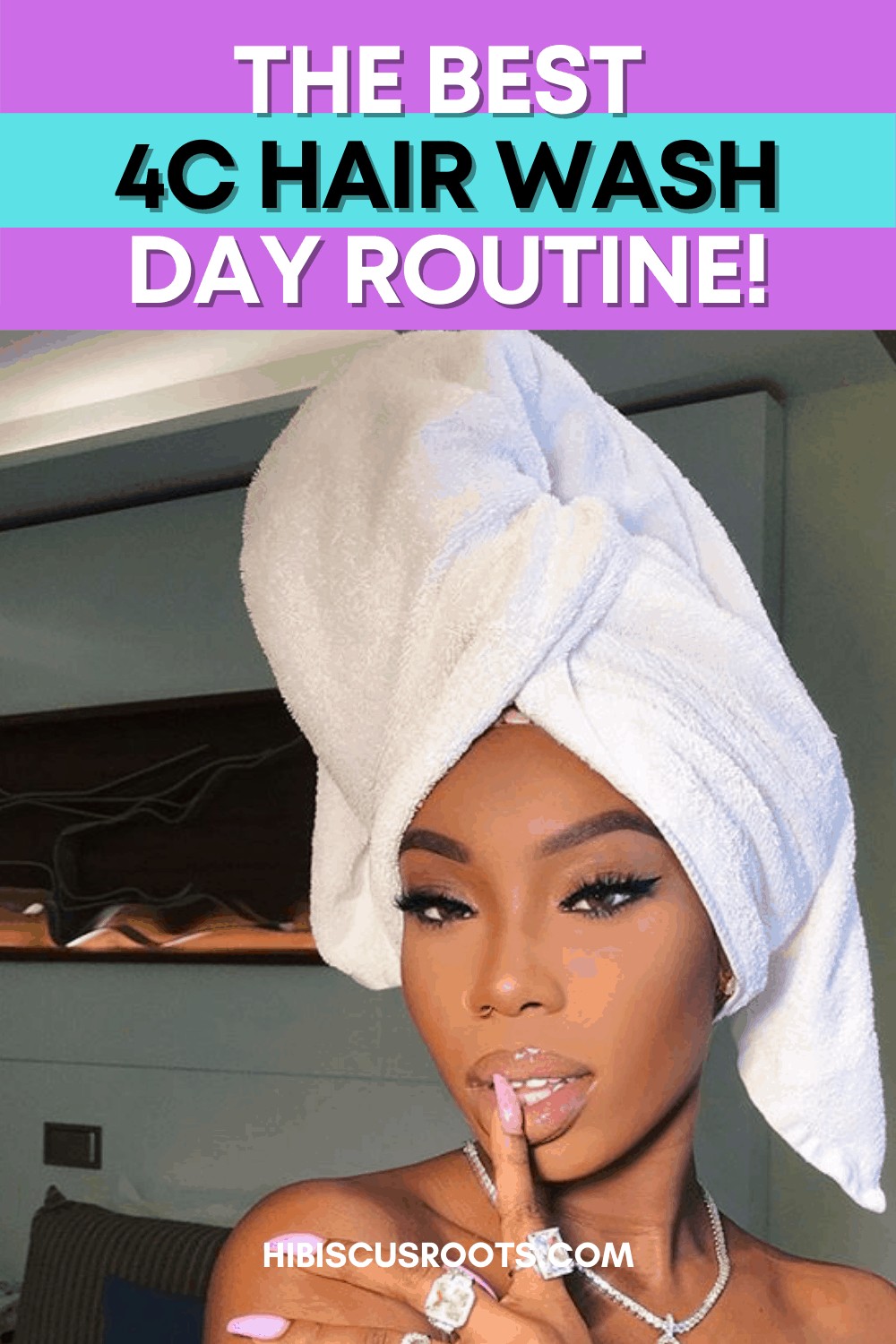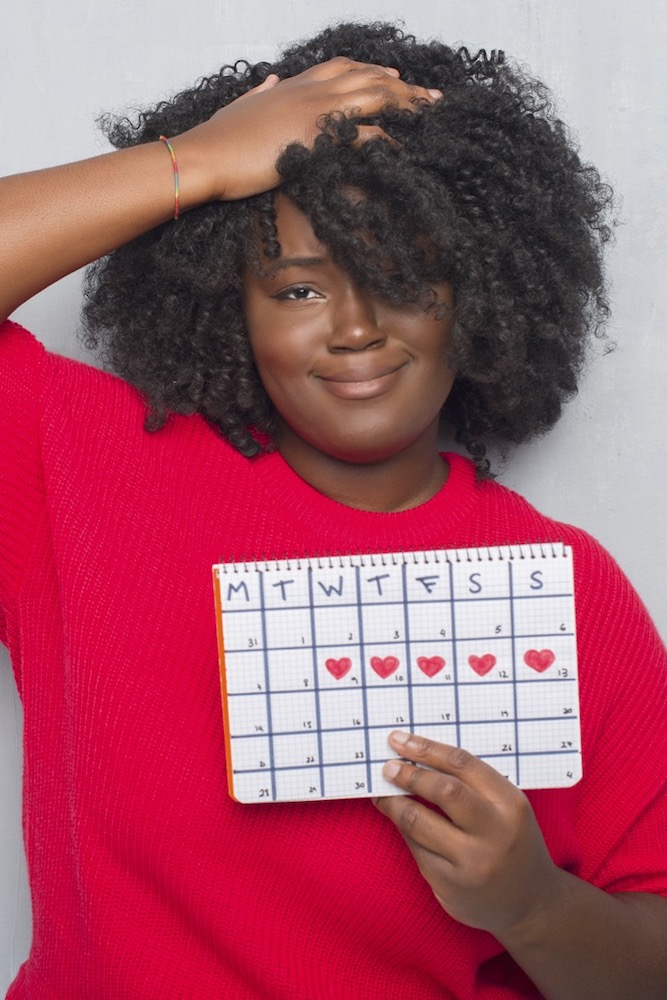Updated: January 5, 2022
If there is one question we get really often here on Hibiscus Roots, it is “how often should I wash my 4C hair.”
We get it, natural hair care is a journey. And one of the most important ways to care for your natural hair is to wash it properly.
In this article, we’re going to be going over all the different ways to wash your 4c natural hair, and how often you should wash it. We’ll also talk about why it’s necessary to properly wash 4c natural hair.
Finally, we’ll talk about how to co wash 4c natural hair, and whether or not you should be doing it.
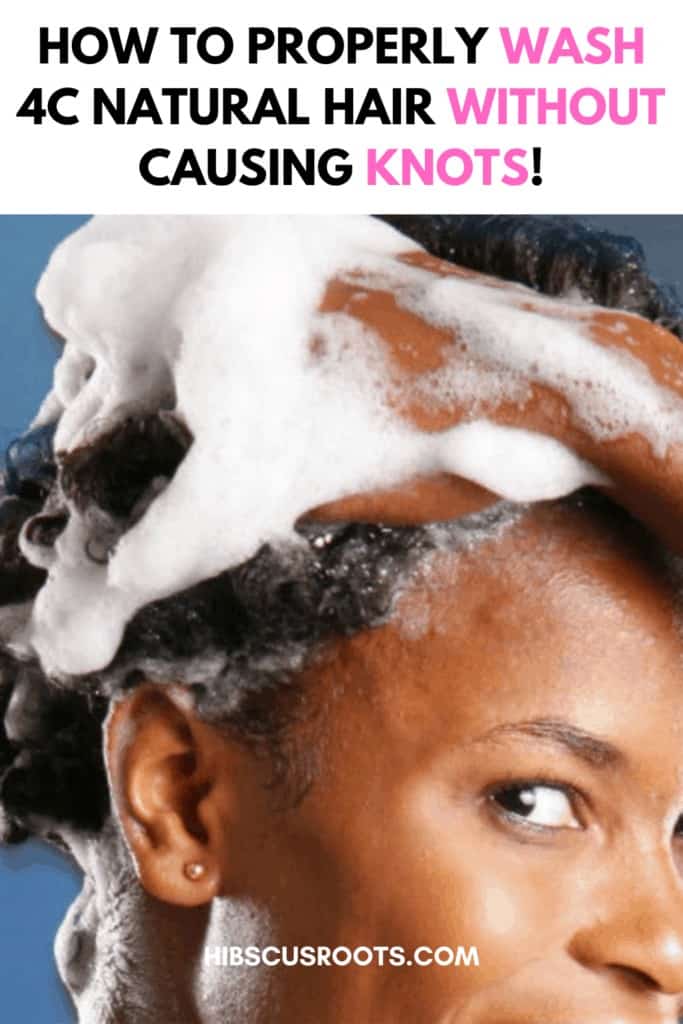
Why it’s Important to Wash 4C Natural Hair Properly
No matter how careful you are, washday is often when you do most of the damage to your natural hair! Fortunately, you can prevent all of this!
Washing your natural hair properly:
- Prevents knots and tangles, reducing the number of trims you need and improving length retention.
- Keeps hair organized, reducing the likelihood of tangles.
- Prevents excessive shrinkage.
- Prevents breakage.
- Ensures a healthy scalp environment.
- Prevents product build-up.
And the more we prevent all of these things, the more length we can retain.
Now we’re going to be covering all the best ways to wash natural hair properly.
How to Wash 4c Hair in Sections
In my humble opinion, unless your 4c hair is very short, it should only be washed in sections.
This is the best way to minimize tangles while washing. This also ensures that every single hair strand is cleansed properly.
Washing your natural hair in sections means you won’t accidentally miss a spot while you’re washing your hair. It also means you get better access to your scalp to clean it properly.
Another reason why you should wash your 4c hair in sections is to make sure you give every section the same amount of cleansing and care.
4c hair naturally shrinks up and tangles on itself.
As such, the best way to minimize the risks involved with washing natural hair altogether is by washing it in sections.
- To do this, depending on the length and thickness of your natural hair, part your hair into 2, 4, or even 6 sections. Make the part with your fingers as part of your pre-poo process. You can read more about the pre-poo process here. You really don’t need a comb for this! If your hair is longer, you can get away with washing it in fewer sections. However, if it is a shorter-medium length, more sections can help you keep your hair organized.
- Once your hair has been sectioned, secure each section with a clip or a scrunchie to make sure that your hair doesn’t unravel when it’s wet.
- If any part of your hair is delicate, like the crown of your hair, the nape, or the edges, make sure that you keep them in a separate section. Do this so that you can care for the unique needs of that section of hair.
- To begin the wash process, let the preferably filtered shower water run over your entire head. (You can get this shower-head water filter)
- Once your hair is drenched, unravel one section and apply your cleanser to it. (Shut the water off while you’re washing each section so you don’t use up all the hot water! 😉 )
- Hold the length of your hair in your hands and keep it stretched while you scrub your scalp with the tips of your fingers.
- Once you’re done scrubbing the scalp in that section, gently run the lather down the length of your strands (without rubbing).
- Rinse out the soap from that section and clip it back up. Repeat the process on that section if necessary, depending on the cleanser or how dirty your hair is.
- Go through each section repeating steps 5 – 8.
- Once you’ve washed all the sections, wash the edges as well as the nape of your hair carefully.
- Finally, let the water run over your entire scalp and hair as a final rinse!
How to Wash 4c Hair in Twists
Another great way to minimize tangling and breakage during wash day is by washing your hair in twists. You can either wash your hair in medium or large mini-twists or in twists you install as part of your pre-poo process.
Never wash your hair in small or extra small mini twists!
4c hair is more likely to tangle and form single strand knots when it is wet in small mini twists. So to wash your 4c hair in twists:
- Spray your hair with water or aloe vera juice to break down your existing hairstyle.
- Once your hair is damp or moisturized, begin to lightly finger detangle it and separate it into smaller sections. You can read our article about how to detangle natural hair properly here.
- Every time you separate and finger detangle a section of your hair, twist this section. Your twists can be as large as you want (without the risk of unraveling) but should be no smaller than the width of your index finger (to prevent tangling).
- You can apply your pre-poo product in the process of twisting so it’s a great way to kill 3 birds with one stone! Detangling, pre-poo as well as preventing future tangles!
- Once your hair is twisted up, combine the twists to form larger sections.
- Now, wash your hair in sections as in the instructions we previously described.
Lathering the section, scrubbing the scalp, running product down the length of your hair, and rinsing. - However, when washing the hair in twists you want to be intentional during the washing process. Since your hair is twisted, squeeze the product into the twists to make sure the hair is clean all the way through. Similarly, you want to squeeze the hair as you rinse to ensure that all the product is rinsed out.
- Depending on the length of your hair or your experience with hair care, you can decide to wash all your twists loose.
To some people, the twists are already manageable enough to wash all at once.
However, I still like to wash my twists in 4 sections, one after the other to make sure I’m thorough!
How to Wash 4c Hair without Shampoo
If you’ve been in the natural hair community for a while, you may have heard of the practice of no-poo or low-poo. This is based on the premise that shampoo is too harsh or drying for 4c natural hair.
The response was to either not use shampoo at all (no-poo), and cleanse 4c hair with conditioner instead — to co wash. Or, to use shampoo only once in a while (low-poo), and co wash the rest of the time. Check out this post for more information about cowashing — how to cowash, and the pros and cons.
These days, natural hair products are much better than they used to be. They now come in options that are moisturizing and healthy for natural hair. But unfortunately, this stigma around shampooing natural hair is still around.
So I completely understand why you would be curious about how to wash your 4c hair without shampoo! Not all shampoos are bad but I’m going to be showing you a few alternatives if you still prefer to cut shampoo all together!
Alternatives to Shampoo for Natural Hair
1. African Black Soap Shampoo – Heavy Cleanser
An African black soap shampoo is a great way to cleanse your natural hair without traditional shampoo. It involves liquefying authentic black soap and adding oils as well as humectants to it to make sure it doesn’t dry out your hair. We have a full African black soap shampoo recipe here.
This is because, on its own, African black soap is a pretty powerful natural cleanser.
In my own natural hair regimen, I use an African black soap shampoo like a clarifying shampoo. I wash my hair with a medium or light cleanser every other week, and then I use a black soap shampoo when my hair needs a deep cleanse or a reset. And if I need my shampoo to be more moisturizing, I simply add more oils to it or dilute it.
If you incorporate African black soap into your natural hair regimen, you really don’t need to continue using store-bought shampoos.
You can customize your shampoo recipe depending on what your hair needs each washday!
2. Clay Washing – Medium Cleanser
Instead of washing your 4c natural hair with shampoo, you can opt for a Rhassoul Clay Wash. Clay washing is a great alternative to shampoo because of its natural cleansing, detoxifying and dirt-removal properties. You can find our full rhassoul clay wash recipe here.
The grains of the clay act as a mild scrub for your scalp, helping to lift oil and dirt. Rhassoul clay is also antimicrobial and cleanses your hair and scalp without stripping it completely.
I KNOW it doesn’t seem like it, but you can have a successful Ayurvedic natural hair regimen by only using a clay wash to cleanse your scalp.
Do keep in mind that the more all-natural your natural hair care regimen is, the more successful you will be with all-natural cleansers. If you mostly use Ayurvedic herbs, oils, butters, and aloe vera juice on your hair during the week clay washing will be sufficient for cleansing your hair.
However, if you use store-bought products like heavy stylers or petroleum-based hair grease — those might just be a little too heavy-duty for clay washing only. You may need to incorporate a heavier cleanser from time to time.
3. Aritha Shampoo – Mild Cleanser
Using a DIY cleanser like Aritha (or Soapnut, Areetha, Reetha) is a great way to gently cleanse your natural hair. Soapnut is rich in saponins and natural surfactants, that gently remove excess oils and dirt from the hair and scalp.
You can even mix aritha shampoo with another light cleanser like aloe vera juice or apple cider vinegar for a deeper cleanse. But this is a great way to wash your 4c natural hair without shampoo especially if you don’t have excess product build-up on your hair or scalp!
You can find our full rejuvenating DIY aritha shampoo recipe here!
4. Aloe Vera Juice or Apple Cider Vinegar – Extra Mild Cleansers
Spraying your scalp directly with aloe vera juice and DILUTED apple cider vinegar is a great way to gently cleanse your hair without shampoo.
You can spray your scalp, massage it and wipe off the excess dirt and oil which can be lifted by the Aloe Vera Juice or ACV. All this without even wetting your hair.
This is a great way to keep your scalp fresh between washdays, or while your hair is in protective styles.
When using Aloe Vera juice, you can use a mixture of 50% Aloe Vera to 50% water.
You can also use 100% aloe vera juice — depending on your hair’s tolerance.
You can read more about using aloe vera juice as a cleanser here.
However, when it comes to Apple Cider Vinegar, it should always be diluted. You can use a mixture of 1 part ACV to 5 parts water! You can read more about using ACV in 4C natural hair care here.
5. Co Washing – HR Thoughts
Co washing is the act of cleansing the scalp and hair with a conditioner. Unfortunately, because conditioners do not typically have cleansing properties, this is not an effective way to cleanse your 4C natural hair.
It’s a great way to boost moisture levels in your natural hair. However, it cannot remove dirt or excess oil from your hair or your scalp.
The goal of a conditioner is to cling to your hair shaft: reinforcing it or lubricating it. When we cleanse our natural hair, we want a product with the opposite effect. We want something that removes products from the hair shaft rather than adds more to it.
Unfortunately, if we only ever co wash our hair, we end up suffocating the hair strand. We are adding lubrication to the strand without ever removing it. This is no way to improve the health of your hair.
Especially since we have discovered all these natural, non-stripping ways to shampoo natural hair now! 😉
You can check out this highly informative video from Green Beauty about the disadvantages of co washing 4c natural hair.
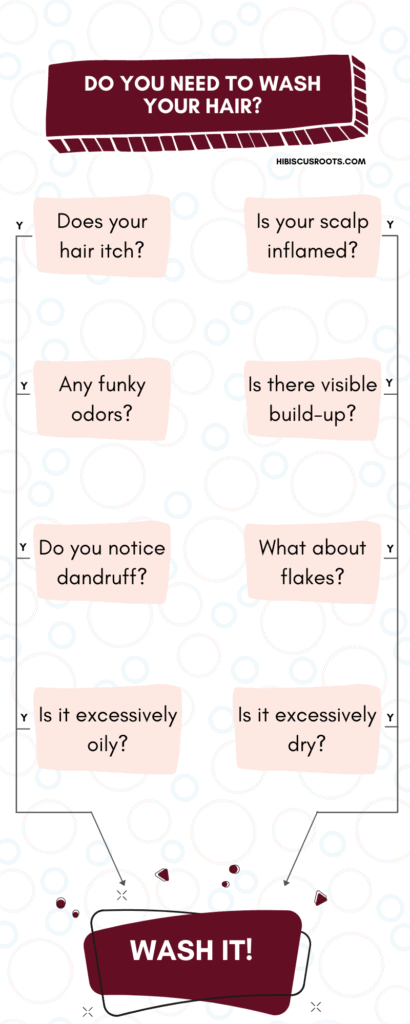
How Often Should You wash 4c Natural Hair?
To keep 4C hair healthy, you can wash it as often as once a week to once a month. How often you wash your 4c natural hair will depend on the following factors:
1. The natural cleanser you use
If you use a store-bought shampoo to wash your 4c hair, you may need to wash your hair less often because of the potential drying effects of the product. However, if you typically use a mild or extra-mild cleanser, you can wash your hair very often with little consequence. As long you properly moisturize and seal your hair afterward.
2. The products you use between wash day
If most of the products you use are light, or all-natural, then you may not have a lot of product build-up at all. You can get away with using a mild cleanser once in a while to maintain clean hair. However, if you use heavy gels or hair grease, then you may need a heavy cleanser pretty often to rid your hair of the product.
3. Your sebum production
If you naturally don’t produce a lot of sebum on your scalp, then you may not need to wash your hair very often at all. You will need to wash out any oils you put in your scalp but you will not suffer if you postpone washday. People who produce a lot of sebum on the other hand may find that once their hair is dirty, they have no other choice but to wash it often.
4. Your lifestyle
If you are someone who works out, sweats, or goes swimming a lot, then you will need to wash your hair more often than someone who doesn’t.
Conclusion
All of these factors are why we really don’t like to talk about schedules here at Hibiscus Roots. If your hair feels itchy, you observe the build-up of gunk on your scalp, or your hair is extremely dry, then wash it.
If your hair feels fine, then don’t.
We say this because we know a lot of people with healthy natural hair who wash their hair every 4 days, like Kimberley Cherell. Some others wash their hair every 4 months like Indigenous Strandz. Now, I wash my hair every 2 weeks, though I have sometimes gone 4 weeks without washing it when my hair didn’t need it.
I do this because I’ve learned that its what MY hair likes and needs. At the beginning of my hair journey, I used to wash my 4c hair TWICE a week (shampoo on Saturday, co wash on Wednesdays). Because I read on some hair forum that’s what I was supposed to do.
My hair didn’t need it and I suffered from hygral fatigue but I stuck with it because that was THE RULE. That’s why now we recommend that you find what works for your OWN hair and stick with it.
Please.
Unfortunately, getting a prescription about natural hair often means we stop what we’re doing even though it works. Because we read somewhere that we had to do something else.
Your natural hair journey is extremely personal. So please don’t let anyone tell you otherwise!


